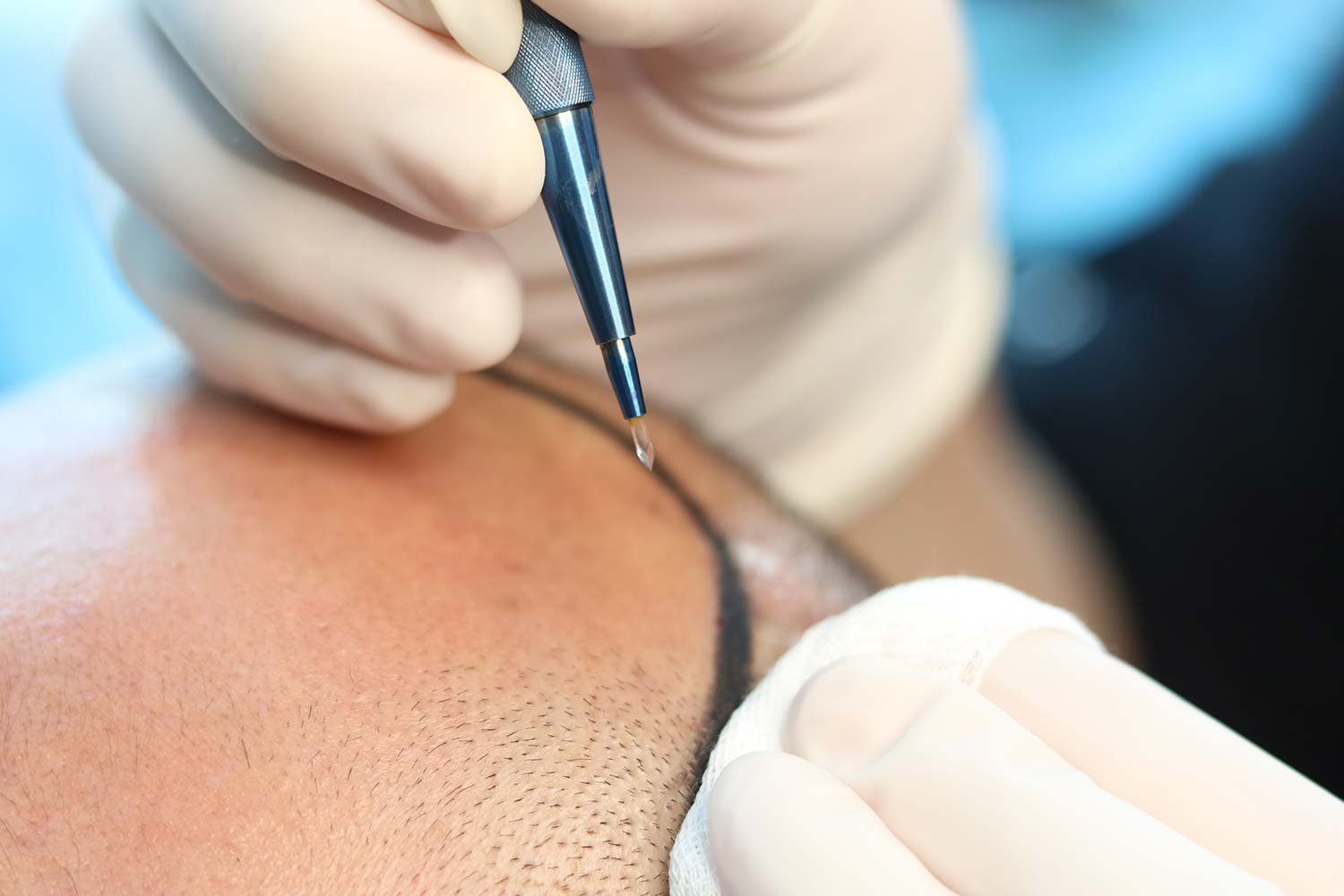While women lose hair almost as much as men do, fewer women than men go for hair transplant procedures. For women suffering from hair loss, this guide provides a useful resource for everything you need to know about hair transplants for women.
Women love their hair. And it shows. From a gazillion hair products to the fuss around their hairdresser to the hours dedicated to hair washing day; female hair is a serious business.
So when their hair starts to thin, the horror of it is indescribable. Curiously, of the people who undergo hair transplant procedures, women only account for 13%, with men taking up a whopping 87%.
That aside, it’s undebatable that hair loss is distressing and can affect a lady’s self-esteem. Luckily, there are numerous hair loss remedies to consider, including hair transplants.
Hair Loss in Women
It’s normal to lose 50 to 100 strands of hair daily and 250 hairs on days when you wash your hair.
Hair loss becomes noticeable if you start losing more than this.
You are said to have hair loss when:
- Excessive amounts of hair are left on a comb after combing
- Your hair starts thinning
- You find lots of hair in the drain, on your pillow, and your clothes
- You get areas of your scalp where your scalp is easily visible
Hair loss in women happens differently than in men. You might have heard of the male pattern baldness known as the Norwood hair loss pattern, where male hair tends to thin at the forehead or the crown of the head.
On the other hand, female hair loss entails thinning on the top third to half of the scalp. This is known as the Ludwig hair loss pattern. As a result, your ponytail may be less dense than it used to be, you see more scalp when you pull your hair back, or your mid part gradually becomes wider.
A woman can also have an advanced Ludwig, where hair loss is severe, with little to no hair in the affected regions. This much hair loss is rare, and when it does happen, it often stems from a health issue.
Here are some common reasons for extreme hair loss in women:
Androgenetic Alopecia: Androgenetic Alopecia is a common cause of hair loss in both men and women. This type of hair loss is caused by increased Androgens in the body. Androgens are sex hormones. This can result from menopause or polycystic ovarian syndrome.
Aside from androgens, there are other hormonal changes and changes that can cause hair loss. These include pregnancy, thyroid dysfunction, and menopause.
Telogen Effluvium: this is hair loss caused by a traumatic event such as stress, major surgery, and childbirth.
What happens is that trauma causes the hair to transition into the resting phase of growth. After the resting phase, hair goes into the shedding phase, where you lose clumps of hair. This process triggers faster hair loss, that’s a lot more noticeable.
Anagen Effluvium: this is associated with chemotherapy. Chemotherapy causes severe hair loss by damaging hair follicles at the cellular level.
Alopecia areata: this happens when an inflammatory reaction causes your immune system to attack hair follicles.
Traction alopecia: sometimes, some hairstyles look better and last longer if made tightly. However, this can create excessive tension on the scalp. Doing this for long periods can cause the hair to begin falling out.
You can also suffer from traction alopecia from broken hair shafts. These can result from excessive use of blow dryers, hot combs, and dying and straightening chemicals.
Vitamin D and Iron deficiency: a vitamin D deficiency can cause your hair to thin over time. An iron deficiency can also increase hair loss. This is seen more in women that suffer from heavy menstruation.
There are several hair loss remedies for women, including hair transplants.
Hair Transplantations for Women
A hair transplant is a surgical procedure that involves taking healthy hair follicles from one part of the head and implanting them in the areas experiencing hair loss. The portion of the head where the hair is harvested from is called the donor area and is usually at the back of the head.
The harvested hairs are placed in a pattern that allows them to blend in with the existing hair and look as natural as possible. This also means that these new hairs should be placed in a way that the new growth occurs in the same direction as existing hair.
As we have just seen, hair loss in women can be attributed to several reasons. This makes hair transplants for women slightly more complex than hair transplants for men.
For one, extensive tests must be conducted to determine the root cause of the hair loss before deciding whether a transplant will be an effective remedy.
Whether a transplant will be effective is based on the following factors:
- How much hair loss is being experienced
- The specific cause of the hair loss
- The health of the remaining hair, with a particular focus on the possible donor areas
- Whether or not a woman’s hair loss is likely to worsen in the near future
Similarly, women don’t have large bald areas; they have diffuse thinning, which calls for a more intricate implanting process than male hair transplants.
Another challenge is that many women’s hair will thin on the entire head, which makes it more challenging to find viable donor hair.
How Much Will a Hair Transplant Cost?
A hair transplant typically costs upwards of $5,000 but can cost well over $15,000. Also worth mentioning is that your health insurer is unlikely to cover the transplant because it’s widely considered a cosmetic procedure.
The cost disparity for hair transplants comes about because each hair transplant patient has unique needs, and other external factors are at play. By and large, what you pay for your procedure will be dependent upon;
- Expertise: Well-trained, highly experienced surgeons will charge more for the procedure than newly graduated surgeons.
- Clinic’s location: clinics in big cities or those housed in prime areas of a city will charge more than clinics in smaller towns housed in affordable locations.
Similarly, big cities’ rents, wages, and overheads are higher. This is reflected in the cost of the procedures performed.
- The extent of hair loss: the more hair loss suffered, the more grafts required to cover the thinning areas. Subsequently, the higher the cost.
- Aftercare: the aftercare determines how much you spend overall. For example, you will have an open wound after a FUT transplant. Therefore, the aftercare for this will be more involving than with a FUE transplant. As a result, costs for the former will be higher than those for the latter.
- Travel: if you choose to go abroad, you must also factor in travel, transfer, and accommodation costs.
How Are Female Transplants Done?
The first step to your new hair is consulting a hair transplant surgeon.
Here, the surgeon will take your medical history. This helps them determine if you would be a good candidate for a hair transplant. They can also begin to evaluate which procedure would be most effective and safe for you.
The surgeon will also assess your hair and scalp. They will evaluate the extent of hair loss and possible donor sites. This examination can help them determine the number of hair grafts needed to provide good density if they are available and even cost estimates.
Your surgeon will also look for any contraindications for a transplant, meaning any signs that might make you a poor candidate for the procedure.
Some include:
- Any medical issues or a patient taking any medications that are contraindicated
- Unreasonable expectations about short and long-term results
- Mental illness
- Donor area miniaturization
- Unusual hair loss pattern
- Scalp inflammation, unexplained scarring, or other severe dermatological issues
- Burning, skin or scalp pain or pruritus
Feel free to discuss your expectations and the results you wish to see. Reputable surgeons will tell you what they can realistically achieve, so make an informed decision. They can also show you before and after photos of their previous clients so you see firsthand what is attainable.
Similarly, ask and discuss any questions and concerns you might have, and if you are ready, book a date for the surgery.
The surgeon will also likely discuss the techniques used. Two methods predominate hair transplants: FUE and FUT.
FUT Hair Transplant
Here is a breakdown of how a FUT (Follicular Unit Transplantation) transplant is conducted.
1. You will lie in the prone position, and the hair at the donor site will be trimmed to 2mm.
2. The surgeon will mark a calculated strip length and inject anesthesia. You can also be offered or request a sedative.
3. The surgeon will cut a strip of skin bearing healthy hair follicles.
4. You will have an excised wound, which the surgeon will suture and bandage. They can also apply a topical antibiotic
5. After this, hair follicles will be extracted from the strip carefully to keep them intact.
6. The surgeon then makes small incisions on the implant site, and the harvested hairs are transplanted following your existing hair pattern.
7. Depending on the type of sutures used, part of your aftercare might include stitch removal from the donor site.
FUE Hair Transplant
A FUE (Follicular Unit Extraction) improves the FUT technique and is slightly less invasive. Here is a snapshot of how it’s conducted:
1. The donor site is shaved to about 2mm to allow better follicle visibility
2. The patient is placed in the prone position and injected with local anesthesia
3. The surgeon uses a 0.8mm to 1.2 mm punch and forceps to extract healthy hair follicles from the donor site.
4. Small incisions are made to the thinning areas, and the harvested hair follicles are transplanted.
A FUE tends to have a shorter recovery time than a FUT. Part of the reason for this is that, unlike a FUT, there is no open wound on the scalp that needs dressing and cleaning. With no open wound, the chances of an infection are also lower.
However, your surgeon will probably send you home with antibiotics after either transplant to help keep infections at bay.
Follow your outlined aftercare routine to the letter. This will ensure you recover in good time and that the transplanted hair takes off as it should.
Debunking the Myths
Now that we know a bit about hair loss in women, it’s also important to separate truth from fiction.
Some widespread myths about hair loss include the following:
- You are losing hair from perming it or shampooing it too much
- Dandruff causes permanent hair loss in women
- If you shave your hair, it grows back twice as thick
- Standing on your head increases circulation, stimulating faster hair growth
- Brushing your hair 100 strokes a day makes your hair healthier
- Hair loss only affects intellectual women
Women Hair Transplants FAQs
Can I have multiple transplants?
Yes, you can. Some women will not achieve the desired density with one transplant. In such cases, subsequent transplants can be carried out in the future.
When can I see the changes in my hair density?
The results of a transplant are not visible immediately.
Most people begin seeing some changes six months after the procedure. However, full results won’t set in until after 12 to 18 months. This is because the transplanted hair will go through the typical hair growth phases, including shedding.
After about 18 months, even though the transplanted hair might not be as long as existing hair, it should be thicker and fuller.
How long do hair transplants last?
A hair transplant will last you a lifetime. However, you might still suffer from hair loss in the future from age, hormonal imbalances, medication, and so on.
Is a hair transplant painful?
A hair transplant is done under local anesthesia and shouldn’t be painful. However, you might experience some discomfort during recovery, more so with a FUT, as you will be healing a sutured wound. However, the pain shouldn’t be anything you can’t manage at home with painkillers.
See our “Is a Hair Transplant Painful?” article for more information about what to expect.
Have Your Hair Transplant Done Right
While a hair transplant is a minor surgery, many things could still go wrong. This is why your choice of clinic is crucial.
We have it all at the Philadelphia Hair Restoration Center. This includes highly qualified surgeons, high-tech equipment, and a relaxing, sterile environment to ensure each transplant is carried out within the highest standards. That aside, our billing is straightforward, and we provide comprehensive pre and post-operative care to ensure a smooth procedure and quick recovery.
What more could you need? Call us for a free consultation today.




